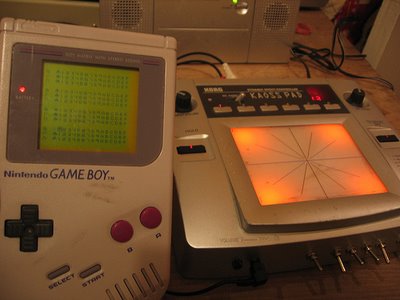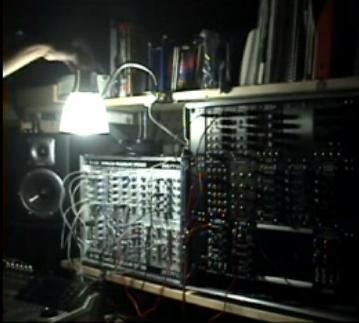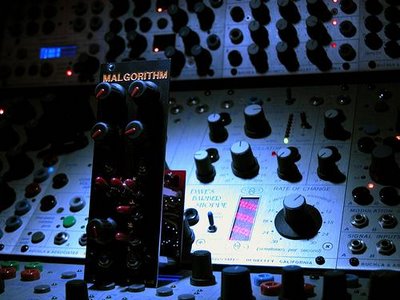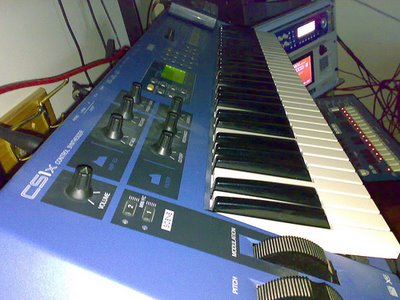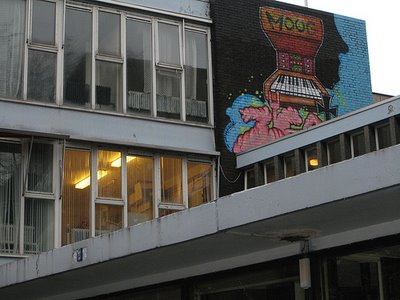 Title link takes you to a recording of a transistor radio being fed through a MOOG Moogerfooger MURF on SoNiCbRaT.
Title link takes you to a recording of a transistor radio being fed through a MOOG Moogerfooger MURF on SoNiCbRaT.
Thursday, December 21, 2006
C o N v E r S a T i O n S
 Title link takes you to a recording of a transistor radio being fed through a MOOG Moogerfooger MURF on SoNiCbRaT.
Title link takes you to a recording of a transistor radio being fed through a MOOG Moogerfooger MURF on SoNiCbRaT.
ZeroPoint on Synthwire
 Title link takes you to a post on Synthwire on ZeroPoint, an artist with some interesting homebrew gear. Pictured here is two square wave oscillator. You can find more after the hop.
Title link takes you to a post on Synthwire on ZeroPoint, an artist with some interesting homebrew gear. Pictured here is two square wave oscillator. You can find more after the hop. BTW, if do not regularly check out Synthwire, you might want to start checking back more often. Some recent entries include "A warning to those buying ASys modules in the US," "Free 10 Minute Classic Electronic Track" [gas0095 - this is really, really good stuff], and "Maintenance" [MOOG 960 sequencer chips]. BTW, if you want to post on Synthwire, shoot me an email and I'll add you. Title link takes you there.
More Fairlight on DVDBORN
Title link takes you to a post on DVDBORN with a number of videos featuring the Fairlight and a few resource links. Above is Revolting Cocks - TV Mind (Live sept'87). You can see the Fairlight monitor in the keyboard rig. I saw them live in 1990 . I don't remember seeing the Fairlight, but then again, my memory of that time is pretty fuzzy. : )
The ATARI Hotz MIDI Translator
Click here for the ATARI Hotz MIDI Translator page on the Atari Museum site [BTW, do check out the rest of the site for more retro Atari goodness]. You can find two more images of the Hotz MIDI Translator on Sendling.
If you look at the image in this post you will see the translator on the left. Note how much thinner it is than the unit on the right with the ATARI logo. If anyone knows what the unit on the right is, please feel free to comment.
Update: Check out the comments for more links. The unit with the ATARI logo is the same as the other. It's just the back, and it's tilted up for a flat surface.
PAiA Programmable Drum Set

Click here for images via this auction
Some of the Details pulled:
"From the manual:
'"While most electronic rhythm units offer only a limited choice of pre-determined rhythm patterns, the PAIA Programmable Drum Set allows the user to tailor the pattern, time signature and drum sounds to each application. Among the unique features provided by the unit are touch sensitive electronic controls and the provision for an independently structured bridge rhythm."
From an interview with John Simonton (founder of PAIA)
"'That's been credited as the first programmable drum machine, and it may be. For about a year, it was dominant, because there weren't any other programmable drum sets."
Larry Fast (Synergy) wrote:
"1978 I built one of John's Programmable Drum machines from a PAiA kit. As far as I know, that was the first ever drum box that the user could program patterns into and store them in battery backed up RAM. I showed it to Peter Gabriel who loved the concept. Marvin Jones put together another one for Peter to keep. That became the basis for all of the electronic drums on PG#3 (Games Without Frontiers, Biko and many others). From that came the LinnDrum a few years later. Thanks John, for single-handedly changing how we make records."
My comments:
You can program drum patterns, and store them. This was a new beginning for electronic drums and sequencing.
I built this unit from a kit in 1980.
I have been an electronics hobbyist and musician for over 40 years. When I first saw this unit, I knew I had to have one. I saw it as an opportunity to learn about touch switches, drum patterns, analog sound sources (oscillators, white noise generators), and digital logic. I also imagined using the logic control circuit to trigger other analog sound sources. The term sequencing had yet to be used on drum machines because prior to this unit the previous electronic drum machines only played fixed patterns. I built some other sound sources, but never integrated them into this unit. I preferred the internal sounds. This drum synth has a unique sound."
Wednesday, December 20, 2006
Kurzweil VA 1 Video, Samples and More
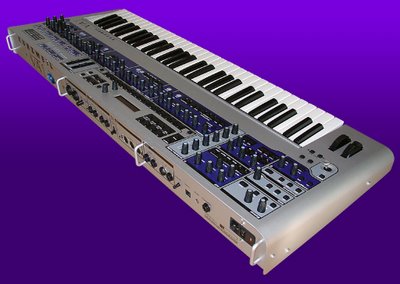 Title link takes you to a Kurzweil VA 1 site sent my way via Roger. You'll find video, mp3s, images and more. I found the videos best played by downloading all of them and then loading them all up to play one after the other as one piece. The VA 1 prototype was shown at Frankfurt back in 2004. It was never released, and most of us just assumed Kurzweil canceled the project, however earlier this year there was a rumor that it might be coming this year. If anyone knows anything about it, please feel free to comment. I'm curious as to how many prototypes were made and if any are floating around out there.
Title link takes you to a Kurzweil VA 1 site sent my way via Roger. You'll find video, mp3s, images and more. I found the videos best played by downloading all of them and then loading them all up to play one after the other as one piece. The VA 1 prototype was shown at Frankfurt back in 2004. It was never released, and most of us just assumed Kurzweil canceled the project, however earlier this year there was a rumor that it might be coming this year. If anyone knows anything about it, please feel free to comment. I'm curious as to how many prototypes were made and if any are floating around out there.
Doepfer Universal AD/DA module
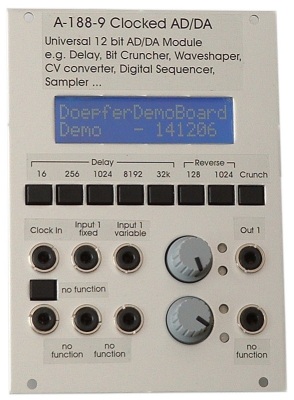 "The picture shows the first prototype of the universal AD/DA module. In principle this module is nothing a clocked AD/processor/memory/DA chain. AD means Analog-to-Digital converter, i.e. the analog voltage (audio or control voltage) is converted into a digital format with 12 bit resolution. The digital signal is processed or delayed by a microcontroller with a large memory and then converted back into the analog voltage by an Digital-to-Analog converter. The prototype has two AD inputs (with attenuator), two clock inputs, 2 pairs of LEDs, and two DA outputs as for certain functions (e.g. voltage controlled bit crusher or waveshaper) two voltages are necessary. The mode is selected by means of 8 buttons and a LC display.
"The picture shows the first prototype of the universal AD/DA module. In principle this module is nothing a clocked AD/processor/memory/DA chain. AD means Analog-to-Digital converter, i.e. the analog voltage (audio or control voltage) is converted into a digital format with 12 bit resolution. The digital signal is processed or delayed by a microcontroller with a large memory and then converted back into the analog voltage by an Digital-to-Analog converter. The prototype has two AD inputs (with attenuator), two clock inputs, 2 pairs of LEDs, and two DA outputs as for certain functions (e.g. voltage controlled bit crusher or waveshaper) two voltages are necessary. The mode is selected by means of 8 buttons and a LC display.Examples for processing (without using the delay memory): bit crusher, bit exchanger, audio and CV waveshaper, Hz/V-to-V/Oct converter and vice versa, and many more. In principle everything that can be realized by calculating the AD output using certain rules and then converting the result into a voltage by the DA converter.
Examples for processing (with delay memory): clocked audio/CV delay with adjustable memory length between 128 (e.g. for flanger or Karplus/Strong) up to one million (for long audio delays many seconds or even minutes), digital sequencer (i.e. recording/storing/plaing back a CV).
The clock input is used to trigger AD/DA conversion. For audio signal processing the clock has to be in the audio range or beyond (e.g. from a VCO or high speed VCO). For CV processing the clock can be slower.
The final module(s) will probably look different. The prototype is used as a kind of defelopment tool to find out which function are useful. As soon as we made our first experiences and have found out what is possible we will probably start a poll in the A-100 Yahoo group how many different modules with which kind of controls should be released after all. The prototype will be probably shown at the NAMM booth of Analogue Haven in January."
via sequencer.de
ghost duo
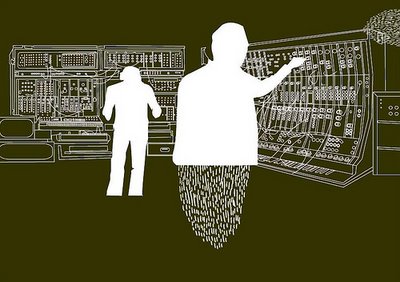 flickr by Removethatnow.
flickr by Removethatnow."they play one song, which is the love theme from risky buisness but with decades of reverb on it so you can only just make it out"
Voyager Matrixsynth Edition
 Via Bee Jay in the comments of this post:
Via Bee Jay in the comments of this post: "Happy Christmas, Matrix! may all your (synthy) dreams come true!"
Thanks! : ) A Matrixsynth green Voyager would indeed be a dream come true. Man, that looks nice. Bee Jay saw my Voyager Fire edition post and created a mock-up of the ad with a Matrix Edition. Something tells me the Matrix edition would not fly due to the Movie, however a Matrixsynth edition probably would. I had the site and the green on black before the movies folks - back in Oct' 97. BTW, I ran the idea by someone at Moog and they said we would need to order 50 of them, so... We'll see. If anyone out there can pull any strings...
Update: Also posted on SoNiCbRaT. Thanks Bee Jay! Thanks SoNiCbRaT! One day....
Replicant on Audio Damage
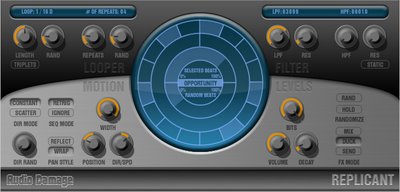 The Replicant product page is up with the feature list and samples. According to Chris on Analog Industries, it should be out before the new year.
The Replicant product page is up with the feature list and samples. According to Chris on Analog Industries, it should be out before the new year.Features:
» Tempo-based delay and looping effects, from 1/128th note to an entire measure.
» Six independant randomization controls, for subtle changes or extreme aleatoric madness, including a global randomize button.
» Our unique "Hold" feature, to store a random sequence you like.
» Resonant low-pass and high-pass filters that change over time.
» Pan position that changes over time.
» Two separate direction modes, for entire events or individual repeats, with randomization.
» Full MIDI Learn for hardware control of every parameter. (VST only; handled by host in AU version)
Tuesday, December 19, 2006
Waldorf Q+ Track via SCD
 Title link takes you to SCD (Something Completely Different). Under the Music section you will find tracks sectioned by year. Each track lists the gear used. You'll find the Waldorf Q+ only track under 2003, titled Rainbow 2 (direct link). Do make sure to check out the other tracks as well. It's a great way to hear what some of these synths sound like and it's all good music on its own.
Title link takes you to SCD (Something Completely Different). Under the Music section you will find tracks sectioned by year. Each track lists the gear used. You'll find the Waldorf Q+ only track under 2003, titled Rainbow 2 (direct link). Do make sure to check out the other tracks as well. It's a great way to hear what some of these synths sound like and it's all good music on its own.Previous SCD posts.
RSF Kobol Expander

Click here for more shots pulled via this auction.
Snip from the details: "It's very well laid out & intuitive to use and the default signal path is printed on the front panel (though damn near every function can be re-routed with a simple patchcord). Has a lot of cool voltage control that one doesn't normally see outside of a very well specified modular--- VC envelopes, filter resonance, LFO, VCO waveform, VCO amount to filter (!), etc, etc. And, of course it has the SSM 2040 filter, in my opinion the best sounding lowpass filter ever (beats the Moog 904A by a hair in my book). I had mine mounted in a rack below the CP-251 and VX-351 CV expander from my Moog Voyager and had a hugely flexible, ridiculously powerful and compact full-blown modular system. I highly suggest the purchaser invest in a Moog CP-251, as it adds much needed mults and Sample & Hold and makes a perfect companion to the Kobol."
sent my way via synth ollie.
Modular Patches
 Title link takes you there. Each image links to a different sample featuring a Deopfer modular. After checking them out, make sure to track back to the root of the site, Vogelscheiss for more. All music via Charles Graef.
Title link takes you there. Each image links to a different sample featuring a Deopfer modular. After checking them out, make sure to track back to the root of the site, Vogelscheiss for more. All music via Charles Graef.Previous Vogelscheiss posts.
Minilogue/hitchhikers choice - short version (longer on DVD)
YouTube via kristoferstrom. Sent my way via Dave Manley.
Details via kristoferstrom:
i made this stopmotion video for minilogue this summer, this is the short version.
all made on whiteboard so...no undo/redo
the long version will be available on the DVD.
released on crosstown rebels
www.minilogue.com
www.ljudbilden.com
myspace.com/ljudbilden
www.nosordo.com
www.crosstownrebels.com
my other username "ljudbilden":
+a stressed portfolio...still uploading stuff [link]
+a stressed portfolio...still uploading stuff
Waldorf Nano Samples and Manual
Oberheim OB-X
 Title link takes you to shots pulled via this auction. The current bid is at $3,227.00. I'm guessing the following is why.
Title link takes you to shots pulled via this auction. The current bid is at $3,227.00. I'm guessing the following is why.Some Details:
"The classic Oberheim OB-X was only made for a short time, and is hard to come by! The “X” has some of the smoothest and fullest sounds ever to be produced by analog keyboards. Later versions were “chipped out,” including the later OB-Xa and the newer synths. Nothing beats the OB-X when it comes to sweeps and big thick pads, as it is based on the old SEM design complete with Temco regulated VCO’s and largely discrete filters. It has 32 program memories, polyphonic portamento, and polyphonic sample & hold.
This unit underwent a complete overhaul, by Tony Clark of Great Lakes Modular, in late 2005. This included new trim pots, new capacitors, several replacement pushbuttons, cleaning of the keyboard contacts, and a recalibration. He has an excellent website (including before-and-after pictures) that shows his work, at this link.
This is an 8-voice synthesizer. Originally it was bought as a four-voice, with four more voice-cards added in 1984. Since the unit was manufactured as a 4-voice, you might notice that the back label indicates it is a 4-voice model.
The J.L. Cooper MIDI retrofit dates back to the 1980’s, and includes MIDI in and MIDI out, with note on/off, and program change supported: pitch bend and modulation control are NOT supported. A company called Encore Electronics currently has a newer MIDI retrofit that does a superior job. If you win the auction, I’d frankly recommend you check out their product at the following link.
In the picture with the pitch-bend/mod levers, you’ll notice a “remote/local” switch. When the switch is in “local” mode, the unit works absolutely normally. Switching to “remote” allowed me to use a Korg RK-100 keytar to remotely control the unit via MIDI. The switch was necessary because I also had to use a custom control-voltage connection to use the pitch-bend and mod-wheel. This custom connection was made via an extra 5-pin XLR jack on the back of the unit.
serial # is 803514"
Psychic Modulation
 Title link takes you to Psychic Modulation, makers of a range of VSTs including synths, FX, and tools. Pictured is Cerebrum, a VST groovebox with the following specs:
Title link takes you to Psychic Modulation, makers of a range of VSTs including synths, FX, and tools. Pictured is Cerebrum, a VST groovebox with the following specs:Specs:
-4 drum synth modules
-3 drum sample synth modules
-1 bass synth module
-Each of the 7 drum modules has it's own Wavlayer for layering with user samples
-2 16-step pattern sequencers for each module
-Automatic beat matching functions for each sequencer
-2 accent switches for each sequencer(for gain, reverse, glide, glitch etc.)
-2 velocity grids for each sequencer(for pitch, level, filter, glitch rate etc.)
-4 types of random probability for each sequencer
-Each sequencer has independant control of speed, direction, length, etc.
-Host sync
-Keybard mappings for drumlines, bassline and one-shot drums
-Polyphonic option for all synths as well bass sequencer
-Volume/Panning vectors
-Onboard drum mixer
-Multiple audio outputs (channels 1-6)
-32 presets
MOOG Voyager Fire Edition
 Via Electrocomp-101 in this VSE thread: "Page 29 in this months Sound on Sound Magazine: Turnkey has an ad for Moog Voyager Fire edition with Pink Lights and Mohangany Wood...." If anyone has an image of it, please post a comment.
Via Electrocomp-101 in this VSE thread: "Page 29 in this months Sound on Sound Magazine: Turnkey has an ad for Moog Voyager Fire edition with Pink Lights and Mohangany Wood...." If anyone has an image of it, please post a comment.Update: here's a scan sent my way via Oliver.
Club of the Knobs 2007 Catalog
 Title link takes you to Club of the Knobs, where you will find their latest 2007 catalog. Direct link here.
Title link takes you to Club of the Knobs, where you will find their latest 2007 catalog. Direct link here.via sequencer.de.
Monday, December 18, 2006
New Order live, 1984, 'Blue Monday'
YouTube via adz1962. Two Voyetra 8s in a rack, two Voyetra Keyboard controllers, Prophet 5, and Eumulator. Not sure what the synth behind her is yet. Maybe another Prophet 5? I'm guessing that's the Oberheim DMX being triggered in the beginning.
Update via ortho in the comments: "here is an article in soundonsound about the dude who tried to make this song not sound like such total shite live."
CYLOB
 "2 copies of Supercollider / CMS Environment were run at the same time, one feeding the Mackie mixer and one feeding the Gemini. Seperate channels were mixed on the Mackie while different loops were selected using the joypad. Inbetween these tracks, secondary loops were played through the Gemini mixer and crossfaded/ punched in as required. All stopping and starting of tracks was achieved manually! Most of the sounds are
"2 copies of Supercollider / CMS Environment were run at the same time, one feeding the Mackie mixer and one feeding the Gemini. Seperate channels were mixed on the Mackie while different loops were selected using the joypad. Inbetween these tracks, secondary loops were played through the Gemini mixer and crossfaded/ punched in as required. All stopping and starting of tracks was achieved manually! Most of the sounds are 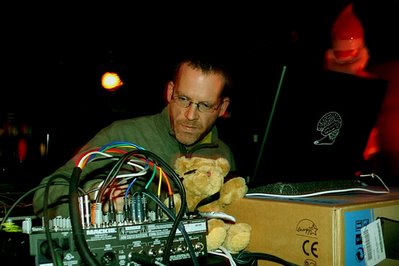 synthesised, although many of the drum sounds are samples, and there are a few "bass waves" sampled from analogue synths."
synthesised, although many of the drum sounds are samples, and there are a few "bass waves" sampled from analogue synths."And a teddy bear for good measure.
: )
Title link takes you to more info including more images, videos and samples.
Synth Abuse - Devo
Devo-That's Good
Abuse: Playing chords on the monophonic SH-101
YouTube via electronictomato. Reported by davetron in the comments of this post.
Devo - Come Back Jonee
Abuse: Possible abuse playing the Polybox as the lead. Anyone know if the Polybox is capable of the sound being played?
YouTube via Spudboy. Reported by Greggo in the comments of this post.
Abuse: Playing chords on the monophonic SH-101
YouTube via electronictomato. Reported by davetron in the comments of this post.
Devo - Come Back Jonee
Abuse: Possible abuse playing the Polybox as the lead. Anyone know if the Polybox is capable of the sound being played?
YouTube via Spudboy. Reported by Greggo in the comments of this post.
Oberheim FVS Sample
 Title link takes you to a thread on VSE featuring a sample of the Oberheim Four Voice System via Biboulon. Direct link to sample here, for when the thread disappears to limbo. Send my way via Biboulon.
Title link takes you to a thread on VSE featuring a sample of the Oberheim Four Voice System via Biboulon. Direct link to sample here, for when the thread disappears to limbo. Send my way via Biboulon.
SK1s
 Another flickr by nakedintruder. I love the colors of these. Title link takes you to the nakedintruder's set of flickr shots including more of these and some other synths.
Another flickr by nakedintruder. I love the colors of these. Title link takes you to the nakedintruder's set of flickr shots including more of these and some other synths.
Synth Patents
 In case you missed it, title link takes you a post on Music Thing with various musical instrument related patents found on Google's patent search. Google released the new search service just last week, but I didn't think about searching synth patents. Pictured here is an excerpt from Bob Moog's patent on his High and Low Pass Filters. Pretty cool. Title link takes you to a few more on Music Thing.
In case you missed it, title link takes you a post on Music Thing with various musical instrument related patents found on Google's patent search. Google released the new search service just last week, but I didn't think about searching synth patents. Pictured here is an excerpt from Bob Moog's patent on his High and Low Pass Filters. Pretty cool. Title link takes you to a few more on Music Thing.
Vgermuse Studio Shot 2
 No title link. Another shot via vgermuse.
No title link. Another shot via vgermuse.EML-101, Cricklewood Keyboard, Moog Voyager, MOTM, VCS3, EVI-2000, Serge Modular.
Update via Reed in the comments of the previous post: "He just did an album... [link]"
Vgermuse Studio Shot
Sunday, December 17, 2006
ARP Odyssey and Little Brother Scan
 No title link. Just the shot pulled via this auction. I haven't seen this one before.
No title link. Just the shot pulled via this auction. I haven't seen this one before. via brian comnes.
Flock Of Seagulls - I Ran
YouTube via milla202. Inspired by this thread on VSE. So is it a Roland SH-09, SH-2 or actually an RS-09? Although he's playing more than one note at a time in the vid, which would default to the RS-09, I'm seeing the SH-09 based on the knob placement. What the hell is it with people playing chords on monophonic synths?
Roland SH201 v SH101 Synth Shootout--Gearwire Crosstalk #018
YouTube via gearwire. Via Music Thing. Tom of Music Thing says Gearwire is like Wayne's World for synths. I didn't make that connection until now. Funny! : ) You can see more of their videos here. You be the judge. Regardless, good stuff. Here's the Vocoder video they refer to.
Mystery Synth
 See if you can guess what this one is. ; )
See if you can guess what this one is. ; ) via Greg.
Update: Alex got it right in the comments. It's an ornament.

Demo synth AMS-16 and drums ADS-8
"DIY synth AMS-16 and drums ADS-8 presents www.enmusic.by.ru"
YouTube via enginmusic. Sent my way via frederic.
Update: I sent an email to AH asking if anyone had more info on these. The following are the replies:
Florian
"The Drumsynth reminds to a tama TS305/306 series.
The Monosynth is according to a link in the kyrillian text an adaption of Ray Wilsons Soundlab Minisynth and the sequencer is derived from Thorsten Kloses software projects."
Synth Ollie:
"the drumsynth is based om some old e&mm diy-syndrum articles, synbal and syntom II"
PAiA 4700 and More on Music of Plexus
 Remember these posts featuring Plexus and his PAiA 4700 modular? Title link takes you to a new page featuring tons more.
Remember these posts featuring Plexus and his PAiA 4700 modular? Title link takes you to a new page featuring tons more.This one via Plexus,Tor Olav, and Cynthia.
Synergy II and Kaypro II Computer
 Title link takes you to shots pulled via this auction. Note this Synergy is not working.
Title link takes you to shots pulled via this auction. Note this Synergy is not working.Details: "The Synergy II+ is famous as the synthesizer that Wendy Carlos used on the legendary recording "TRON" [actually it might have been the GDS according to this] and "Beauty in the Beast", the Synergy took place of Wendys Moog modular system on these recordings. The Synergy is a Phase Modulation/Additive synthesizer. Phase Modulation is similar to FM found on the popular synthesizers like the Synclavier and Yamaha DX instraments synths however the Synergy has FAR more settings and tones when it comes to crafting the ultimate in synthesized music.
The Phase Modulation algorithms are user defined with up to 16 oscillators available.
The envelopes have up to 16 stages/per osc, and are loopable.
Program/sounds consists of 2 'boundaries' which are 2 separate timbres.
The keyboardist can morph between these timbres via velocity and key number.
Voice allocation is highly advanced, allowing for very complex keyboard splits/layers/voice cycling.
There are many advanced features on the DK SYNERGY II that have never been equaled or surpassed in other synthesizers of the era. The DK SYNERGY II synthesizer originally retailed for around Six Thousand 6$K and the adittional kaypro II computer to accompany it around Thirteen hunderd dollars $1.3K."
Sent my way via Matt.
EMS Vocoder 1000
 Title link takes you to shots pulled via this auction.
Title link takes you to shots pulled via this auction.According to the auction this is serial number 1. Some Details: "The Vocoder 1000 is a 16 band model and has great intelligibility, along with a lot of cool features like adjustable and VC slew rate/shape with freeze input, pause stuffing from either input with adjustable release time, built-in oscillator, etc. In short, this is a serious big-league vocoder... not quite a Sennheiser, big Synton or EMS 5000, but definitely far beyond the Roland/Korg/MAM league.
Before listing, I did a few Google searches on this model and there's not a lot of information other than Jarre using one in 1978. The owner's manual is dated at 1984 and has a picture of an older 1000 with a disclaimer that "the photo of the Vocoder 1000 on the following page differs slightly from the unit which you have, although the two units are electronically identical." It goes on to describe the differences (added features, better HF response, jacks in different places) and then goes on to say "FOR VOCODER 2000, PLEASE READ VOCODER 1000" and then the rest of the manual refers to it as the Vocoder 2000. So my theory is that the 1000 was originally released in 1978, there was a second revision (of which this is serial #1) was released in 1984 after Robin Wood took over, and the Vocoder 1000 and 2000 are the same with minor panel differences (and added stuff on the 1000 Rev 2). Please note that I'm just guessing here, but all the info I can find seems to back that up. I can find nowhere that authoritatively discusses the differences between the 1000 and 2000 (except for a post by myself on a mailing list archive, so hardly authoritative) and the manual refers to them interchangably."
If you know more, feel free to comment.
Modding a MOOG Rogue
 Title link takes you to a post with more info and images in German on Synthesizerforum.de. You can find a Google translated version in English here.
Title link takes you to a post with more info and images in German on Synthesizerforum.de. You can find a Google translated version in English here. Features:
- Saw <-> pulse cross fade
- manual PW-attitude
- PWM over Env.
- PWM over key Tracking
- PWM over specially LFO
- LFO with trichloroethylene, Sin, pulse
- LFO speed of approx. 0,5Hz until far into the audio range possible (do not have I yet completely exactly fixed)
- LFO symmetry automatic controllers (Saw e.g. makes from trichloroethylene)
- Connection with the Rogue over parallel haven cable (no parallel interface Sign )
Via sequencer.de.
PREVIOUS PAGE
NEXT PAGE
HOME













© Matrixsynth - All posts are presented here for informative, historical and educative purposes as applicable within fair use.
MATRIXSYNTH is supported by affiliate links that use cookies to track clickthroughs and sales. See the privacy policy for details.
MATRIXSYNTH - EVERYTHING SYNTH













© Matrixsynth - All posts are presented here for informative, historical and educative purposes as applicable within fair use.
MATRIXSYNTH is supported by affiliate links that use cookies to track clickthroughs and sales. See the privacy policy for details.
MATRIXSYNTH - EVERYTHING SYNTH




